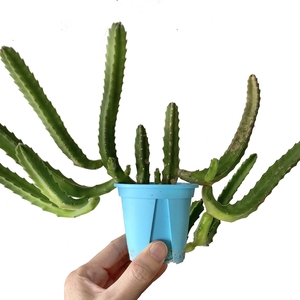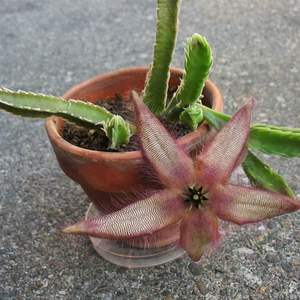植物经验
详细说明
Stapelia gettleffii is a stem succulent that grows in nature under trees and can spread horizontally up to 3.3 feet (1 m) in diameter. The stems are green, decumbent at the base then erect, 4-angled, with toothed ribs, up to 10 inches (25 cm) tall 20-25 cm high and up to 0.6 inch (1.5 cm) across. They turn red in the dry season and become paper-thin. The flowers are exceptionally large, up to 6 inches (15 cm) in diameter, burgundy red and very hairy.
How to Grow and Care
Several species are fairly easy to grow. Others, often those with slightly hairy stems and the more unusual flowers, are more challenging and require careful watering (with some fertilizer) during the growing season and complete withdrawal of water during the winter months. A minimum winter temperature of 50 °F (10 °C) is acceptable, providing that plants are kept absolutely dry. A heated growing bench or incubator may help delicate plants to get through the colder months. However, many species live under shrubs in habitat and prefer light shade rather than full sun.
A gritty compost is essential, and clay pots are advisable for the more delicate species. Some growers prefer a mineral-only compost to minimize the chance of fungal attack on the roots. A layer of grit on the surface of the compost prevents moisture from accumulating around the base of the stems.
Keeping Stapelias and their roots free of pests such as mealybugs is the real key to success as fungal attack often occurs as a result of damage to stems by insects.
How to Grow and Care
Several species are fairly easy to grow. Others, often those with slightly hairy stems and the more unusual flowers, are more challenging and require careful watering (with some fertilizer) during the growing season and complete withdrawal of water during the winter months. A minimum winter temperature of 50 °F (10 °C) is acceptable, providing that plants are kept absolutely dry. A heated growing bench or incubator may help delicate plants to get through the colder months. However, many species live under shrubs in habitat and prefer light shade rather than full sun.
A gritty compost is essential, and clay pots are advisable for the more delicate species. Some growers prefer a mineral-only compost to minimize the chance of fungal attack on the roots. A layer of grit on the surface of the compost prevents moisture from accumulating around the base of the stems.
Keeping Stapelias and their roots free of pests such as mealybugs is the real key to success as fungal attack often occurs as a result of damage to stems by insects.
花相册 (3)



kensong
2020年04月05日

It has really grown and branched out. Repotted.


kensong
2019年03月31日

This is my first growing diary. From Woan Sein.









